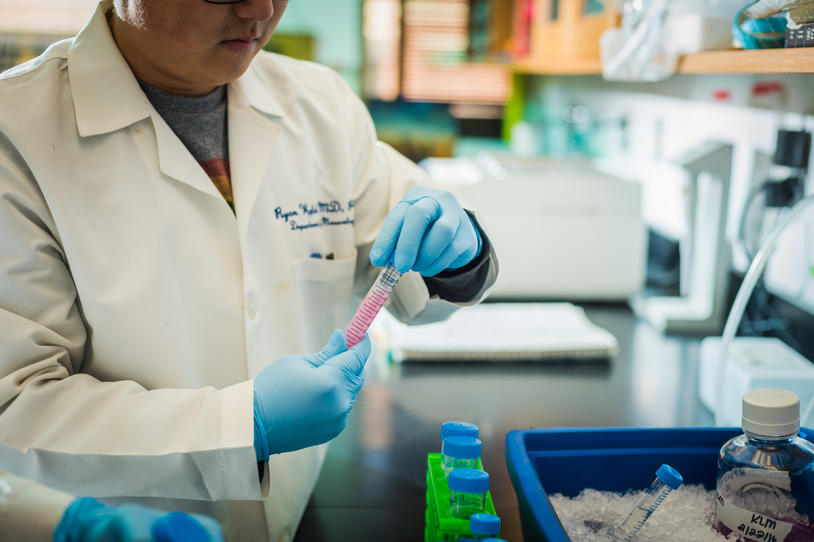
With about 90,000 new Parkinson’s diagnoses in the U.S. each year, the number of people living with the disease — already over 1 million — is outpacing the amount of federal funding allocated for critical Parkinson’s research and care programs.
The good news? Our community can change that.
As Congress works to finalize the 2025 federal budget, we’re asking that they increase or sustain funding for three essential programs:
- The Department of Defense Parkinson’s Research Program
- The Department of Veterans Affairs Parkinson’s Disease Research, Education and Clinical Centers
- The Centers for Disease Control and Prevention National Neurological Conditions Surveillance System
By investigating the links between military service and Parkinson’s disease, ensuring that veterans living with Parkinson’s have access to specialized high-quality care and identifying patterns related to the disease, these programs can tangibly move the needle toward a future without Parkinson’s.
Read on to find out more about these programs, what they do and how you can use your voice to make sure Congress hears our urgent call: Fund Parkinson’s research and care now.

Between 2001 and 2018, the number of military veterans with Parkinson’s swelled by 38 percent to more than 110,000 people. Recognizing an urgent need to offer specialized Parkinson’s care to veterans, the U.S. Department of Veterans Affairs (VA) created Parkinson’s Disease Research, Education and Clinical Centers (PADRECCs) at VA Medical Centers across the country in 2001.
These centers offer state-of-the-art clinical care, education, research and outreach to veterans with Parkinson’s and other movement disorders. Despite the growing number of veterans who have been diagnosed with Parkinson’s, there are only six centers available to serve them, and most are in coastal cities.
The PADRECCs coordinate a network of regional affiliated sites across the VA system, staffed with neurologists and Parkinson’s specialists to provide services to veterans who cannot travel to the main sites. With additional funding, the PADRECCs could create new sites in underserved parts of the country and ensure more staffing and capacity at the existing locations.
Congress has approved a significant but overdue increase in funding for the PADRECCs over the last two years. Now is the time to continue our advocacy and maintain the momentum!

The Parkinson’s Research Program (PRP) at the Department of Defense is one of the only government-funded research programs specifically dedicated to Parkinson’s, playing a pivotal role in advancing our understanding of the disease. The PRP investigates links between Parkinson’s and military service to better support the growing number of veterans living with Parkinson’s today and those who may be affected in the future.
This spring, the House Appropriations Committee began debating funding levels for federal programs, including the PRP. Budget hearings will be held for agencies like the DoD and the Department of Health and Human Services in June 2024.
This program has been flat funded for over 12 years despite mounting evidence of the connection between Parkinson’s and stressors associated with military service, like brain injury and exposure to toxic chemicals and burn pits. Increasing investment will fund high-quality, impactful research to advance our knowledge of Parkinson’s and contribute to better treatments and the search for a cure.

While there are estimates of the number of people diagnosed with Parkinson's in the U.S., we don't have official, comprehensive information about how many people live with the disease, who they are and where they’re located.
In 2016, the Centers for Disease Control and Prevention’s National Neurological Conditions Surveillance System (NNCSS) was established to fuel brain research and science by collecting and analyzing vital demographic information related to neurological conditions like Parkinson’s disease and multiple sclerosis.
The resulting data could help scientists understand much more about Parkinson’s, such as clusters of diagnoses in certain geographic regions, differences in the number of men and women diagnosed and variability in health care practices among patients.
In late 2023, the NNCSS produced its first draft report. By securing more funding, we can ensure the NNCSS completes and expands its reporting and captures the critical data needed to fuel brain science.
Your Voice Can Make a Difference
No one understands Parkinson’s disease better than those who are affected by it every day. Sharing your story with your elected officials can help them understand how their budget decisions can support Parkinson’s patients, families and care partners.
We’ve made it easy for you to do that now — use our simple online form to generate a pre-written email (don’t forget to personalize it!). It only takes a minute, and every message you send gets us closer to a future free from Parkinson’s disease.